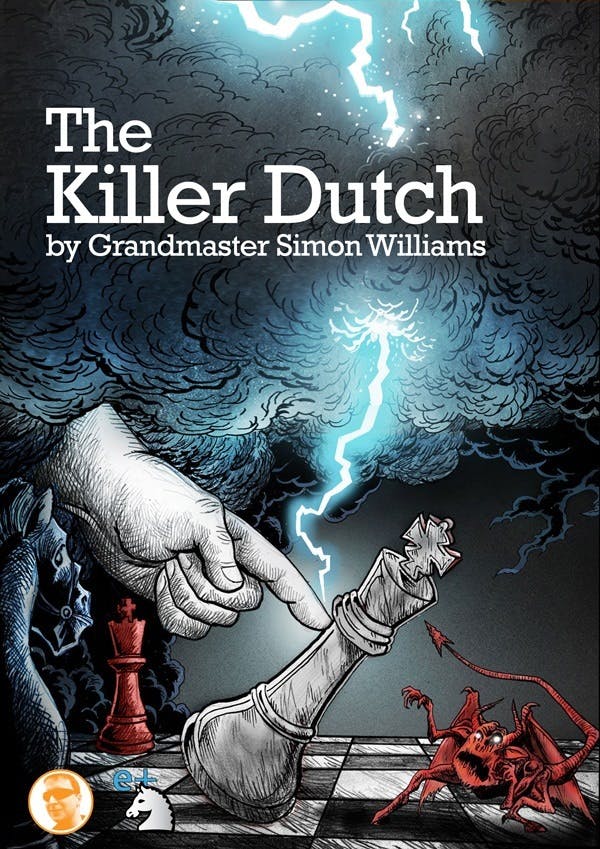

Killer Dutch eBook
with GM Simon WilliamsQuick info
- Format: eBook (PDF)
- Pages: 449pp
- Published: 2013
- File Size: 3 MB
Purchase Options
Before ordering, please read our technical help section. For help and refunds, please contact our support team.

This is a work that has been in the making for the last three years. Originally, this e-book was supposed to be a extension of my Killer Dutch DVD, but the work then took on a life of it’s own.
I am well known for being the worlds leading authority on the Classical Dutch. The opening has brought me victories over some of the best players in the world including Ivan Sokolov, Boris Gelfand and Radaslav Wojtaszek.
I now believe that this e-book is the best and most comprehensive guide to the Classical Dutch, available anywhere in the world.
My original book on the Dutch, Play the Classical Dutch has gone out of print but was voted by New In Chess as "one of the top ten best chess books ever written" (Glenn Flear).
This book was written over ten years ago. The Killer Dutch reflects the cutting edge of chess theory, most of the ideas inside have never been tried in practical chess so there are plenty of interesting ideas to explore!
At £10 I believe this e-book to be a bargain. I am sure it will give the reader an interesting insight into the weird and wonderful world of the Classical Dutch.
Section 1: Introduction
- Introduction
- 1st Introductory Game: R. Wojkaszek vs S.Williams
- 2nd Introductory Game: S. Williams vs Y. Zong Zhao
- History
- 3rd Introductory Game: P. Sowray vs. R. Pert
- Basic Strategic Ideas
Section 2: The Main Line CHAPTER 1: YE OLD FAITHFUL 7...a5
- 7...a5: Introduction
- 1st Introductory Game: Gallagher vs Williams: 7...a5 8 Re1
- 2nd Introductory Game: Iskusnyh vs Williams: 7...a5 8 b3
- The Refutation of 7...a5
- An old way of trying to play against the refutation
- Possible Ways to make 7...a5 playable!?
- Theory A: 7...a5 8 b3
- Theory B: 7...a5 8 Re1
- Theory C: 7...a5 8 Bg5
- Theory D: Other options that White can try on move 8
- Test your knowledge! 7...a5
Chapter 2: The Most Popular Move 7...Qe8
- Introduction
- 1st Introductory Game: Van Wely vs Minasian: 7...Qe8 8 Re1
- 2nd Introductory Game: Taimanov vs Korschnoi: 7...Qe8 8 Qc2
- A Typical Middle game Structure
- Theory A: 7...Qe8 8 Qc2?! and other sidelines
- Theory B: 7...Qe8 8 Re1: The Old Main Line
- Theory C: 7...Qe8 8 b3!: The New Main Line:
- Test your knowledge! 7...Qe8
Chapter 3: The Modern 7...Ne4
- Introduction
- 1st Introductory Game: I. Sokolov vs S.Williams: 7...Ne4
- 2nd Introductory Game: A. Shirov vs S.Williams: 7...Ne4
- A Typical Middlegame Structure: Henrichs vs. Glek
- Theory A: 7...Ne4 Qc2: The thoughtless choice
- Theory B: 7...Ne4 8 Nxe4!: The critical choice
- Theory C: Other 8th Move Possibilities for White
- Test your knowledge! 7...Ne4
Chapter 4: New, Fresh and Slightly Dubious
- Introduction
- Introductory Game: Potomak vs Lukasiewioz: 7...Nc6!?
- Theory A: Let’s take a look!
- Theory B: 7...Nc6!? 8 d5 Ne5 9 Nd4 Nxc4 10 dxe6
- Theory C: 7...Nc6 8 d5 Ne5 9 Nd4 Nxc4 10 Nxe6: The Critical Choice
- Test your knowledge! 7...Nc6?!
Chapter 5: White Plays g3 and Bg2 but Deviates at an Early Stage
- Introduction
- 1st Introductory Game: D. Dumitrache vs S.Williams: An Early b4!?
- 2nd Introductory Game: M. Roelvaag vs S.Williams: An Early Nh3
- 3rd Introductory Game: A. Naiditsch vs S.Williams: An Early Nh3
- Theory A: White Plays an Early Nh3
- Theory B: White avoids playing c4
- Theory C: White Plays an Early b4 or b3
- Other early alternatives that White might play after g3 and Bg2
- Test your knowledge! Early deviations from white after g3 and Bg2
Section 3: White avoids Fianchettoing
- Introduction
- 1st Introductory Game: Agrest vs Williams
- 2nd Introductory Game: Lubbers vs Bok: The Rook Lift!
- Theory A: White plays e3, Bd3, Nge2 and f3.
- Theory B: White plays e3, Bd3 and Nf3?!
- Theory C: White avoids g3, Bg2 and e3 IN FAVOUR OF Other set-ups
- The Colle System/London System: Very popular at club level!
- The London system vs the Dutch: key points
- Introductory game: P. Rebane vs. V. Korchnoi
- The Colle system vs the Dutch
- Introductory game: J. Nielsen vs J. Kristiansen
- Theory of the Colle/London system
- Test your knowledge! White avoids fianchettoing
Section 4: Aggressive set-ups and early gambits
- Introduction
- 1st Introductory Game: Korchsnoi - Kaenel
- 2nd Introductory Game: Tregubov - Malaniuk
- Theory A: The Staunton Gambit
- Theory B: White plays an early h3 and then g4!?
- Theory C: Other crazy side lines!
- Test your knowledge! Aggressive set-ups and early gambits
Section 5: 1 d4 f5 – Early Deviations: 2 Nc3 and 2 Bg5
- Introduction
- 1st Introductory Game: Kharitonov-Gajewski: 2 Bg5
- 2nd Introductory Game: Sakaev-Volokitin: 2 Nc3
- Theory A: 2 Bg5
- Theory B: 2 Nc3
- Theory C: Other Possibilities: 2 Nh3 and 2 Nf3 with 3 d5!?
- Test your knowledge! 1 d4 f5 – early deviations: 2 Nc3 and 2 Bg5
Section 6: White adopts the English set-up and avoids playing d4
- Introductory Game: Karl Mah vs Simon Williams
- ...e6 or ...e5?
- 1st introductory game: I. Johannesson vs S. Williams: ...e6 or ...e5?
- 2nd introductory game: N. Miezis vs S. Williams: ...e6 or ...e5?
- Strategy
- 3rd Introductory Game: M. Hennigan vs S. Williams
- 4th Introductory Game: I. Rausis vs E. Gleizerov
- Theory
- Test Your Knowledge! White adopts the English set-up and avoids playing d4
- Section 7: 1 Nf3: White avoids playing d4 or c4: Including the Lisitsyn Gambit
- Introductory Game: Robert Bellin vs Simon Williams 86: Introduction
- Theory A: 2 d3
- Theory B: 2 e4!?
- Theory C: 2 g3
- Test Your Knowledge! 1 Nf3: White avoids playing d4 or c4: Including the Lisitsyn Gambit
- Players to Study
- Conclusion
Help us improve our website by telling us what you think.
Made by chess players, used by chess players.